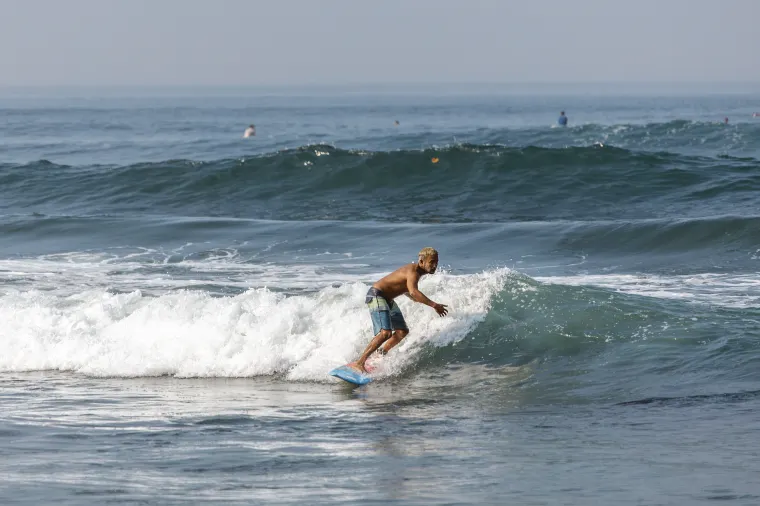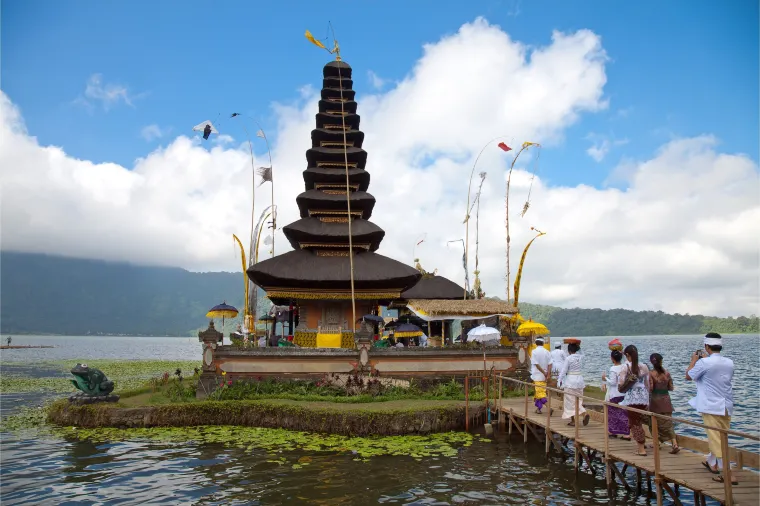
Bali, the Island of the Gods, is one of those places where the weather truly shapes your experience. Sitting just south of the equator, Bali enjoys a tropical climate, meaning it’s warm and humid all year round. But don’t let that fool you—there’s a huge difference between Bali’s dry season (April to October) and wet season (November to March). Trust me, I’ve experienced both, and your choice between them can completely change the kind of trip you’ll have.
If you’re picturing sun-soaked beaches, perfect surf waves, and endless outdoor adventures, you’ll want to time your visit with Bali’s dry season. But if you don’t mind the occasional tropical downpour and love the idea of lush rice terraces, fewer crowds, and cheaper prices, the wet season has its own magic. Either way, you’ll never run out of things to do in Bali—it’s just a matter of choosing the right time for the experience you want.
Weather & Seasons in Bali
🌞 Dry Season (April – October)

This is the best time to visit Bali if you’re after picture-perfect beaches, clear skies, and outdoor adventures. The humidity is lower, the breeze is refreshing, and rainfall is rare—exactly the kind of weather you want for exploring temples, trekking up volcanoes, and sipping cocktails at beachfront bars.
- Weather: Expect 25–30°C (77–86°F) with minimal rain and lower humidity. Nights can be slightly cooler, especially in Ubud, Munduk, and the mountains.
- What to Wear: Stick to light, breathable fabrics, sunglasses, and loads of sunscreen. If you’re heading into the hills, bring a light jacket for those cool evenings.
- Best Seasonal Activities:
- 🏄 Surfing: If you’re a surfer (or want to learn), this is the peak season for west coast waves in Canggu, Uluwatu, and Seminyak.
- ⛰️ Hiking: Sunrise treks up Mount Batur are at their best—no slippery trails, just stunning panoramic views.
- 🤿 Snorkeling & Diving: The waters around Nusa Penida, Amed, and Menjangan Island are crystal-clear, perfect for spotting manta rays and colorful coral reefs.
- 🍹 Beach Clubs & Sunsets: This is when Bali’s beach clubs like Finns, Potato Head, and La Brisa are at their most lively, with golden sunsets over the ocean.
- Festivals & Events:
- 🎭 Bali Arts Festival (June – July): A month-long celebration of Balinese dance, music, and theater—if you love culture, this is a must-see.
- 🪁 Bali Kite Festival (July – August): Watch the skies in Sanur fill with giant, colorful kites as locals compete in this traditional event.
- 📖 Ubud Writers & Readers Festival (October): One of Southeast Asia’s biggest literary events, bringing together storytellers from around the world.
- Insider Tip: July and August are peak months, so book your accommodation early if you want a good deal. If you want great weather without the crowds, visit in May, June, or September.
🌧️ Wet Season (November – March

I know what you’re thinking—rain? On my Bali trip? But hear me out. The wet season in Bali doesn’t mean non-stop rain; instead, it usually comes in short, intense downpours, mostly in the afternoons or evenings. Mornings are often sunny, and the landscape turns into a lush, green paradise. If you don’t mind occasional rain showers and want cheaper flights, fewer crowds, and the most beautiful rice terraces, this could actually be the perfect time for you.
- Weather: 26–31°C (79–88°F) with high humidity and frequent (but short) rain showers. The wettest months are December and January.
- What to Wear: Lightweight, breathable clothes that dry quickly, waterproof sandals, a rain jacket, and mosquito repellent. You’ll thank me later!
- Best Seasonal Activities:
- 🌊 Waterfalls in Full Flow: If you’ve ever wanted to see Tegenungan, Gitgit, or Sekumpul waterfalls at their most powerful, this is the time.
- 🧘 Yoga & Wellness Retreats: Ubud’s wellness scene thrives in the rainy season—perfect for detox retreats, spa days, and meditation.
- 🏄 Surfing on the East Coast: The wet season brings great surf swells to east coast beaches like Nusa Dua, Serangan, and Sanur.
- 🌾 Rice Terraces in Their Greenest Glory: If you want the most Instagram-worthy shots of Tegallalang or Jatiluwih rice terraces, visit in December or January.
- Festivals & Events:
- 🙏 Nyepi (March): Bali’s “Day of Silence” is one of the most unique experiences you can have—no flights, no cars, no lights. Just peace. The night before, massive Ogoh-Ogoh parades take over the streets with giant demon statues.
- 💋 Omed-Omedan (March): Known as the “Kissing Ritual” festival, this is one of the quirkiest celebrations in Bali!
- 🎆 Christmas & New Year’s Eve: Bali is surprisingly popular for holiday getaways, with beachfront parties in Seminyak, Canggu, and Uluwatu.
- Insider Tip: If you’re coming during Christmas or New Year’s, book hotels early—it’s one of the busiest (and most expensive) times. If you want a quieter, budget-friendly wet season trip, aim for February or early March.
🌤️ Shoulder Months (March & November)

If you want decent weather without the peak-season crowds, this is your sweet spot. You’ll get plenty of sunshine, occasional showers, and cheaper accommodation.
- Weather: 27–31°C (80–88°F), mostly dry with some humidity.
- Best Seasonal Activities:
- Enjoy quieter beaches, fewer tourists at temples, and better deals on luxury villas.
- Surfers can catch early wet-season swells in November or late dry-season waves in March.
- Perfect time for road-tripping around Bali—without traffic jams and crowds.
- Insider Tip: If you visit in November, head to Ubud and North Bali—they get less rain compared to the coastal areas.
🌏 Best Time to Visit Bali- Month by Month Guide
Month | Temp (°C/°F) | Rainfall (mm/in) | Travel Tips |
Jan | 26–31°C (79–88°F) | 325mm (12.8in) | Wettest month—expect afternoon downpours. Fewer crowds, lush rice terraces, great for yoga retreats & waterfalls. |
Feb | 26–31°C (79–88°F) | 290mm (11.4in) | Rain continues but cheaper hotels & quiet beaches. Best time for spa days & jungle hikes. |
Mar | 26–31°C (79–88°F) | 210mm (8.3in) | Less rain, more sunshine. Nyepi (Day of Silence) happens this month—plan accordingly! |
Apr | 25–30°C (77–86°F) | 85mm (3.3in) | Dry season begins! Great for beaches, volcano hikes, & diving. Fewer crowds than peak months. |
May | 24–30°C (75–86°F) | 75mm (3in) | One of the best months to visit! Sunny days, great surf, and clear waters for snorkeling & diving. |
Jun | 24–29°C (75–84°F) | 70mm (2.8in) | Peak season starts—expect perfect weather but busier beaches & higher prices. |
Jul | 23–29°C (73–84°F) | 50mm (2in) | Bali at its busiest! Book early for hotels & tours. Perfect time for surfing & cultural festivals. |
Aug | 23–29°C (73–84°F) | 45mm (1.8in) | Best weather, but crowded. Great for beach parties, diving, and hiking. Independence Day celebrations! |
Sep | 24–30°C (75–86°F) | 65mm (2.5in) | Good weather with fewer crowds. Great for adventure activities & exploring temples in peace. |
Oct | 25–30°C (77–86°F) | 85mm (3.3in) | Wet season approaching—still sunny but with occasional showers. Good for diving & cultural festivals. |
Nov | 26–31°C (79–88°F) | 160mm (6.3in) | Rain increases, crowds decrease. Best time for budget travel & quiet retreats. |
Dec | 26–31°C (79–88°F) | 285mm (11.2in) | Christmas & New Year’s buzz! Expect higher prices, rain showers, & lively beach parties. |
🏝️ Crowds, Costs & Festivals: Choosing the Right Time to Visit Bali
🌞 Peak Season (June – August, Late December – Early January)
If you’re dreaming of perfect weather, buzzing beach clubs, and lively streets, this is when Bali is at its most vibrant—and most crowded. The dry season is in full swing, making it ideal for surfing, diving, and exploring, but it also means you’ll need to book everything in advance.
Crowds & Costs:
- High season = high prices. Flights, hotels, and activities are at their most expensive.
- Tourist hotspots like Uluwatu, Seminyak, and Ubud are packed. Expect long waits at popular restaurants and full-booked resorts.
- Traffic can be insane, especially around Kuta and Canggu.
Pros:
✅ Perfect beach weather – sunny skies, low humidity, and minimal rain.
✅ Best time for diving & surfing – crystal-clear waters and great waves.
✅ Major cultural festivals – Bali Arts Festival, Kite Festival, and Christmas/New Year celebrations.
Cons:
❌ Expensive flights & hotels – prices can double or triple.
❌ Crowded beaches, temples, and clubs – finding a quiet spot is tricky.
❌ Harder to book – last-minute deals? Forget it.
💡 Smart Travel Hacks:
- Visit in early June or late August to avoid peak crowds while still enjoying dry-season perks.
- Stay in less touristy areas like Sidemen or Amed for a peaceful getaway.
- Book flights & hotels 3-6 months in advance to snag the best prices.
🌤️ Shoulder Season (April – May, September – October)
This is my favorite time to visit Bali—it’s the perfect balance of good weather, reasonable prices, and fewer tourists. The dry season is just starting or winding down, which means warm sunny days, occasional light showers, and smaller crowds.
Crowds & Costs:
- Lower prices on hotels and flights compared to peak season.
- Quieter beaches & attractions – you won’t have to fight for a sunbed!
- Traffic is manageable, and tours are more relaxed.
Pros:
✅ Best of both worlds – sunny days, good surf, and smaller crowds.
✅ Easier to book hotels & flights without crazy price hikes.
✅ Great for sightseeing – explore Ubud’s temples, waterfalls, and rice terraces in peace.
Cons:
❌ A few rainy days here and there, especially in October.
❌ Not as many big events compared to peak season.
💡 Smart Travel Hacks:
- May & September are golden months – fewer crowds but still peak dry-season weather.
- Look for midweek flights & accommodations to get even better deals.
- Book last-minute deals – hotels and tours are more flexible with discounts.
🌧️ Off-Peak Season (November – March)
If you’re after the best deals and don’t mind a little rain, the wet season is when Bali slows down. It’s not all bad, though—you’ll get lush green landscapes, dramatic waterfalls, and empty beaches at a fraction of the cost.
Crowds & Costs:
- Cheapest time to visit Bali – hotels, flights, and activities are heavily discounted.
- Fewer tourists – perfect for a peaceful retreat or budget-friendly adventure.
- Traffic is light, and tour guides are more flexible.
Pros:
✅ Massive savings – flights and hotels can be 50% cheaper.
✅ Lush landscapes & fewer crowds – perfect for Ubud, jungle retreats, and spa days.
✅ Best time for waterfalls – Tegenungan, Sekumpul, and Gitgit are at their most powerful.
Cons:
❌ Heavy afternoon rain – expect short but intense showers.
❌ Some outdoor activities (like volcano hikes) can be risky due to muddy trails.
❌ Christmas & New Year’s are exceptions – prices spike during the holiday season.
💡 Smart Travel Hacks:
- Travel in February or early March for the best mix of savings and manageable rain.
- Stay in Ubud or north Bali – these areas are even more magical in the wet season.
- Plan indoor activities like Balinese cooking classes, yoga retreats, and spa treatments.
🎉 Major Festivals & Events That Impact Travel
Festival/Event | When | Why It’s Important | Travel Tip |
Nyepi (Day of Silence) | March | Bali’s Hindu New Year—everything shuts down for 24 hours (no flights, no internet, no lights!). | Plan ahead – book a nice hotel and enjoy the peace! |
Bali Arts Festival | June – July | A month-long showcase of Balinese dance, music, and art. | Base yourself in Denpasar or Ubud to catch the best performances. |
Bali Kite Festival | July – August | Sanur’s skies fill with giant traditional kites competing in a spectacular event. | Visit Sanur Beach for the best views. |
Galungan & Kuningan | Twice a year | A major Balinese religious festival celebrating good over evil. | Temples are beautifully decorated—visit Pura Besakih for the most vibrant celebrations. |
Christmas & New Year’s Eve | Late December – Early January | Bali transforms into a party paradise, especially in Seminyak, Canggu, and Uluwatu. | Book early – hotels and flights sell out fast. |
Grab Flight Discounts to Bali
- One way
- Round-trip
- direct cheapest
 CGK19:001h 55mNonstopDPS21:55Jakarta - Bali|Wed, Jan 7|Lion AirPHP 2,486PHP 3,41727% OFF27% OFFPHP 3,417PHP 2,486
CGK19:001h 55mNonstopDPS21:55Jakarta - Bali|Wed, Jan 7|Lion AirPHP 2,486PHP 3,41727% OFF27% OFFPHP 3,417PHP 2,486  CGK18:551h 55mNonstopDPS21:50Jakarta - Bali|Wed, Jan 7|Indonesia AirAsiaPHP 2,763PHP 3,41719% OFF19% OFFPHP 3,417PHP 2,763
CGK18:551h 55mNonstopDPS21:50Jakarta - Bali|Wed, Jan 7|Indonesia AirAsiaPHP 2,763PHP 3,41719% OFF19% OFFPHP 3,417PHP 2,763 CGK19:301h 50mNonstopDPS22:20Jakarta - Bali|Tue, Mar 10|TransNusa AirlinesPHP 2,938PHP 3,41714% OFF14% OFFPHP 3,417PHP 2,938
CGK19:301h 50mNonstopDPS22:20Jakarta - Bali|Tue, Mar 10|TransNusa AirlinesPHP 2,938PHP 3,41714% OFF14% OFFPHP 3,417PHP 2,938 JKT1:00 PM3h 5mNonstopDPS2:00 PMJakarta - Bali|Sat, Dec 20|Lion AirFind More FlightsFind More Flights
JKT1:00 PM3h 5mNonstopDPS2:00 PMJakarta - Bali|Sat, Dec 20|Lion AirFind More FlightsFind More Flights
Displayed flight fares from ${{departCityName}} to ${{arrivalCityName}} are based on average prices across airlines for the next 3 months, according to the latest Trip.com database.
🏝️ Best Time to Visit Bali Based on Your Travel Style
💰 Budget Travelers (Best Time: February – Early March, October – Mid-November)
If you’re like me and love stretching your travel budget, Bali in the shoulder or off-peak season is a dream. Flights and hotels drop by as much as 50%, and you can still enjoy the island without breaking the bank.
Why These Months?
- February – Early March: The wet season is winding down, and prices are at their lowest.
- October – Mid-November: Just after peak season, but before the holiday rush—great deals and decent weather.
Money-Saving Tips:
💡 Book flights at least 2-3 months in advance for the best fares.
💡 Stay in guesthouses or boutique hotels instead of big resorts. Canggu and Ubud have great budget-friendly stays.
💡 Eat at warungs (local eateries)—you can get an amazing Nasi Goreng for under $3!
✨ Luxury Travelers (Best Time: June – September, Late December – Early January)
If you’re here for five-star resorts, fine dining, and VIP experiences, timing is everything. The dry season (June – September) gives you perfect weather for sunset yacht cruises, spa retreats, and private villa stays. The holiday season (late December – early January) is peak luxury travel time, but expect sky-high prices.
Why These Months?
- June – September: Dry, sunny, and perfect for exclusive beach clubs, private tours, and fine dining.
- Late December – Early January: The ultimate luxury escape, with Bali’s best New Year’s Eve parties and exclusive events.
Luxury Travel Tips:
💎 Book high-end resorts and villas at least 6 months in advance—places like The Mulia and St. Regis sell out fast.
💎 Reserve top restaurants early—getting a table at Ku De Ta or Mozaic isn’t easy during peak months.
💎 Opt for private tours to avoid tourist crowds at places like Uluwatu Temple and Ubud’s rice terraces.
🌊 Adventure Seekers (Best Time: May – October)
If your idea of Bali involves surfing legendary waves, diving with manta rays, or hiking volcanoes at sunrise, May to October is your season. The dry weather makes outdoor activities safer and more thrilling.
Why These Months?
- May – September: Ideal for surfing, diving, and waterfall chasing.
- October: Last chance for adventure before the wet season kicks in.
Best Adventures:
🏄 Surfing: May to September brings perfect waves to Uluwatu, Canggu, and Seminyak.
🌋 Hiking Mount Batur: Dry season means no slippery trails—and the sunrise views? Unreal.
🐠 Diving in Nusa Penida & Amed: Crystal-clear waters make this the best time for spotting manta rays and vibrant coral reefs.
Thrill-Seeker Tips:
⚡ Start hikes before sunrise to beat the heat.
⚡ Book diving trips in advance—the best spots (like Manta Point) fill up fast.
⚡ Explore off-the-beaten-path waterfalls—Sekumpul and Aling-Aling are must-visits.
🎭 Cultural Enthusiasts (Best Time: March, June – July, October)
If you want to experience authentic Balinese culture, timing is everything. You’ll want to visit during major religious ceremonies, art festivals, and traditional celebrations.
Why These Months?
- March: Experience Nyepi (Balinese New Year)—a truly unique "Day of Silence."
- June – July: The Bali Arts Festival transforms the island into a cultural paradise.
- October: Galungan & Kuningan, Bali’s most spiritual celebrations, fill temples with vibrant offerings.
Must-See Cultural Experiences:
🕍 Nyepi (March): The entire island shuts down for 24 hours—no flights, no noise, no lights. A rare chance to experience Bali’s spiritual side.
🎨 Bali Arts Festival (June – July): Traditional dance, music, and art performances all over the island.
🙏 Galungan & Kuningan (October): Balinese families honor their ancestors—temples are stunningly decorated.
Culture-Lover Tips:
📸 Visit temples early in the morning for a quieter experience.
🎭 Check local schedules for dance performances in Ubud and Denpasar.
💡 Respect traditions—dress modestly when visiting temples.
👨👩👧 Family Travelers (Best Time: May – July, September – October)
Traveling with kids? I get it—you need good weather, family-friendly activities, and minimal crowds. The dry season (May – July) is ideal, but September – October is a hidden gem for families looking to avoid peak-season madness.
Why These Months?
- May – July: Dry, sunny, and perfect for beach days, animal parks, and kid-friendly attractions.
- September – October: Quieter than peak season, but still great weather for family adventures.
Top Family Activities:
🐢 Bali Safari & Marine Park: Kids love the up-close animal encounters.
🌊 Waterbom Bali: Asia’s best water park—fun for kids and adults.
🚣 Snorkeling in Nusa Lembongan: Calm waters and colorful fish make it perfect for little adventurers.
Family Travel Tips:
👶 Avoid July & August if you hate crowds—theme parks and beaches get packed.
🏡 Book family-friendly villas with pools—easier than hotels with kids.
🛥️ Opt for short boat trips—Nusa Lembongan is kid-friendly, but longer trips (like to Nusa Penida) can be rough.
No matter when you visit, Bali is pure magic. If you’re chasing sunny skies and perfect beach days, plan your trip between May and September—it’s peak season for a reason! Want fewer crowds and lush green landscapes? The shoulder months of March and November strike a great balance. And if you don’t mind the occasional tropical downpour, the wet season (November–March) offers incredible deals and a quieter, more relaxed vibe.
Hotel Recommendation In Bali
Now that you know when to visit, it’s time to start planning your perfect Bali getaway! Need help choosing the best area to stay? Check out our Flight Fares to Bali for the best price. Looking for itinerary inspiration? Explore our Top Things to Do in Bali for must-visit spots and hidden gems.
With the best time to visit in mind, all that’s left is to book your flights, pack your bags, and get ready for the island adventure of a lifetime! 🌴✨
Common Questions About Visiting Bali
What’s the best way to get around Bali?
There’s no public transport system, so your best options are renting a scooter, hiring a private driver, or using ride-hailing apps like Grab and Gojek. If you’re comfortable on a scooter, it’s the fastest and cheapest way to navigate traffic, but only if you have experience (Bali’s roads can be chaotic!). If not, I highly recommend hiring a private driver for the day—it’s affordable, especially if you’re traveling with friends or family. Taxis are available, but always use Bluebird taxis or book through Grab to avoid overpriced fares.How much should I budget per day in Bali?
It depends on your travel style. If you’re on a budget, you can get by on $30–$50 a day, staying in hostels, eating at local warungs, and renting a scooter. Mid-range travelers should expect to spend $80–$150 a day, with comfortable hotels, nice restaurants, and private transport. Luxury travelers can easily spend $250+ per day at five-star resorts, high-end dining, and private tours. Prices in Bali are generally cheap, but beach clubs, Western restaurants, and touristy areas can be pricey.Is Bali safe for tourists?
Yes, Bali is generally safe, but like any tourist hotspot, there are things to watch out for. Petty theft (like bag snatching) can happen, so keep your valuables secure, especially in crowded areas. Be cautious with money exchanges—stick to reputable exchange offices or use ATMs inside banks. Traffic is the biggest danger—roads are hectic, and accidents are common, so if you rent a scooter, wear a helmet and drive carefully. Solo travelers will find Bali welcoming and safe, especially in areas like Ubud, Canggu, and Seminyak.What’s the best neighborhood to stay in Bali?
Seminyak & Canggu – Best for nightlife, beach clubs, and trendy cafes. Ubud – Ideal for culture, nature, and wellness retreats. Uluwatu & Jimbaran – Perfect for stunning cliffs, quiet beaches, and surf. Nusa Dua – Best for luxury resorts and families. Sanur – Laid-back, great for older travelers and families with kids.What’s the best local food to try?
Bali’s food scene is incredible! You must try Babi Guling (suckling pig), Nasi Campur (rice with mixed dishes), and Bebek Betutu (slow-cooked duck). For street food lovers, Nasi Goreng (fried rice) and Satay (grilled skewers) are delicious and cheap. Warung Babi Guling Ibu Oka in Ubud is famous for Babi Guling, and Warung Mak Beng in Sanur serves one of the best fish soups on the islandWhat’s a common tourist mistake in Bali?
Underestimating travel times. Bali looks small on the map, but traffic can be brutal, and getting from Canggu to Uluwatu can take two hours. Another mistake is not dressing appropriately for temples—you’ll need a sarong and a covered top. Also, avoid touching people’s heads (it’s considered disrespectful), and don’t drink the tap water—stick to bottled or filtered water.Do I need cash, or can I use a credit card everywhere?
You’ll need a mix of both. Most mid-range and high-end restaurants, hotels, and stores accept credit cards, but smaller warungs, markets, and local shops are cash only. ATMs are widely available, but always use ones inside banks to avoid scams.Is tipping expected in Bali?
Tipping isn’t mandatory, but it’s appreciated. Many restaurants add a 10% service charge, but if they don’t, leaving 5-10% is a nice gesture. For drivers, tour guides, and spa staff, a small tip (around IDR 20,000–50,000 or $1–$3) is common.

 NO.1
NO.1


